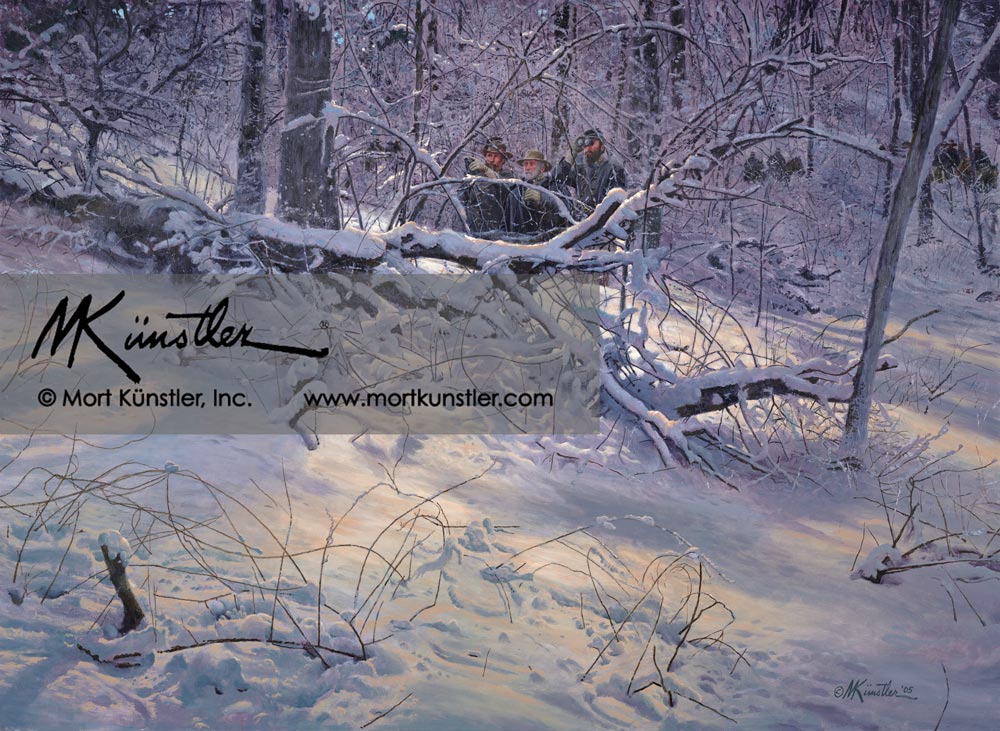The Official Mort Künstler Website
So Close to the Enemy - limited edition print
So Close to the Enemy - limited edition print
Fredericksburg, Va., December 12, 1862
Couldn't load pickup availability
Custom framing is available for this print. Please call 800-850-1776 or email info@mortkunstler.com for more information.
LIMITED EDITION PRINTS
Paper Prints
Reproduction technique: Fine offset lithography on neutral pH archival quality paper using the finest fade-resistant inks.
Each print is numbered and signed by the artist and accompanied by a Certificate of Authenticity.
Image Size: 19” x 26” • Overall Size: 24” x 30”
Signed & Numbered • Edition Size: 750
Signed Artist’s Proof • Edition Size: 100
Giclée Canvas Prints
Reproduction technique: Giclées are printed with the finest archival pigmented inks on canvas.
Each Giclée Print on Canvas is numbered and signed by the artist's daughter, Jane Künstler, and accompanied by a Certificate of Authenticity.
Size: 22” x 30”
Signed & Numbered • Edition Size: 100
Signed Artist’s Proof • Edition Size: 10
Historical Information
It was a daring reconnaissance… and an immeasurable risk. On December 12, 1862, as the massive Northern Army of the Potomac under General Ambrose E. Burnside prepared to assault the Southern lines at Fredericksburg, General Robert E. Lee concluded that he needed additional reconnaissance of the enemy… and decided to do it himself. As a young officer in the Mexican War, Lee had distinguished himself with a foray behind enemy lines, and he apparently had no qualms about reconnoitering close to the Union position this time. Accompanied by his “right arm”, General Stonewall Jackson, and Major Johann Heros von Borcke, Lee moved cautiously through the snow toward Northern lines.
Closer and closer, the high-ranking observers moved, until they were within approximately four-hundred yards of the Federal advance line. Despite the danger, Lee studied the enemy in front of him until he could tarry no more. The next day, the giant Northern army he had observed so carefully would come forward in an attempt to destroy Lee’s army. They held numerical superiority, Lee was assured of that; but he was also confident of his superior defensive position and of the ability of his troops: the Army of Northern Virginia. The battle that followed was one of the bloodiest of the war – and one of the greatest disasters to befall the Union army. So one-sided were the Northern losses, that Lee – watching wave after wave of courageous Federal troops crushed and repelled – remarked to those around him: “It is good that war is so terrible, else we should grow too fond of it.”
The unknown irony of the battle was that the Confederate commander, camouflaged in the snow-covered landscape, conducted a personal reconnaissance within easy range of the Union artillery. Lee, Jackson and von Borcke, were “so close to the enemy,” as von Borcke noted, that the outcome of the battle could have been changed by a single vigilant Northern observer. Undiscovered in his bold foray, Lee directed one of his most significant victories of the war.
Mort Künstler’s Comments
For more than ten years, I’ve wanted to paint this picture. In 1995, I did a sketch of this painting, showing General Robert E. Lee, General Stonewall Jackson and Major Heros von Borcke conducting a reconnaissance of the Northern army in the snow during the 1862 Fredericksburg Campaign. The painting depicts a scene at Fredericksburg recorded by historians Douglas Southall Freeman and James I. Robertson, Jr. Finally! I’ve been able to paint this fascinating scene!
The historians’ account allowed me to paint a snow scene, which I love to do – and during daylight, which is a rarity for me. I always want to surprise and delight the viewer with my paintings, and this was a unique opportunity. Most of my snow scenes are at night and thus are dark canvases. Lee’s December 12th foray occurred at about midday. The morning mist had cleared and this enabled me to paint bright sunlight.
I also decided at this time to feature more of the snowy landscape and camouflage the three officers hiding in the shadows of the woods. I have used the warmer tones of the three figures to contrast with the cool colors of the snow and trees, which leads the eye to the trio. Lee becomes the central figure and focus of attention by designing the branches to point toward him. As one is drawn into the painting, you finally see the mounted escorts in the background. Major von Borcke confessed extreme nervousness that the three officers were “so close to the enemy, who surely little suspected that the two greatest heroes of the war were so nearly in their clutches.”





